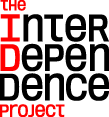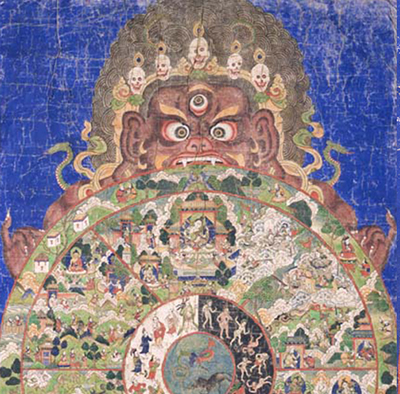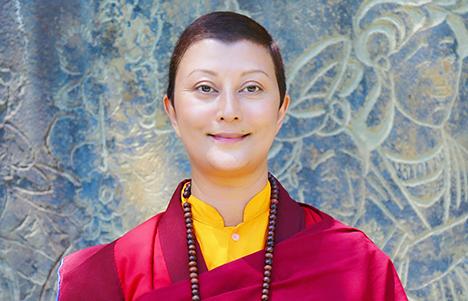
About the Meditation
Meditation session led by Lama Aria Drolma.
The guided meditation begins at 15:30.
For centuries Himalayan practitioners have used meditation to quiet the mind, open the heart, calm the nervous system, and increase focus. Now Western scientists, business leaders, and the secular world have embraced meditation as a vital tool for brain health.
Whether you’re a beginner, a dabbler, or a skilled meditator seeking the company of others, join expert teachers in a forty-five-minute weekly program designed to fit into your lunch break. Each session will be inspired by a different work of art from the Rubin Museum’s collection and will include an opening talk, a twenty-minute meditation session, and a closing discussion.
Presented in partnership with Sharon Salzberg and the Interdependence Project. This program is supported in part by the Hemera Foundation.


RELATED ARTWORK
Theme:Transforming afflictive emotions

The Wheel of Life is a Tibetan Buddhist visualization of the human condition and the endless cycle of birth, death, and rebirth known as samsara. Painted on a striking lapis background, the red, wrathful figure of Yama, the Lord of Death, holds the circle of samsara containing all six realms of existence. He is about to swallow it, reflecting the precarious impermanence of all that exists in these realms.
The center of the wheel portrays the three mental poisons, or kleshas, that keep beings trapped in samsara: attachment (a rooster), hatred (a green snake), and ignorance (a black pig). The next circle, with white and black halves, reminds us how these qualities and their opposites rule our future. The black half shows that negative actions, powered by the three poisons, lead us downward into the lower births. The white half shows that if we practice with the right motivation and right action, we can move upward through the Wheel of Life and ultimately liberate ourselves. The widest circle depicts the six realms of possible rebirths within samsara: hell beings, hungry ghosts, animals, human beings, demigods, and gods.
Along the outer edge, the twelve links of dependent origination symbolize how consciousness becomes trapped in samsara under the power of ignorance, which leads to actions with karmic repercussions, the sensual desires of the body and mind, mental grasping at pleasures and existence, and ultimately birth, old age, and death.
About the Speaker

Lama Aria Drolma is a formally authorized Buddhist teacher trained in the Karma Kagyu tradition of Tibetan Buddhism. She has over a decade of monastic study and meditation training and is a graduate of the three-year, three-month traditional Tibetan Buddhist retreat, an advanced cloistered meditation training program at Palpung Thubten Choling Monastery, New York.
She is respected as a leading expert in Mindfulness Meditation and has trained extensively in the Dharma Path Program of Mindfulness and Contemplations at Palpung Thubten Choling Monastery, New York.
Lama Aria Drolma teaches worldwide, leading retreats, workshops, and corporate meditation programs, and she is a popular guest speaker at universities and organizations. She teaches Vajrayana Buddhism and Buddhist principles, making them relevant to our everyday lives, helping us cultivate loving-kindness and compassion, and bringing about a transformation of contentment and well-being.
